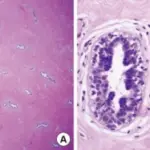Atypical ductal hyperplasia is the intraductal clonal epithelial cell proliferation with similar histologic features, but insufficient involvement or volume for the diagnosis of the low grade ductal carcinoma in situ.
What is the Pathology of Atypical Ductal Hyperplasia?
The pathology of atypical ductal hyperplasia is:
-Etiology: The cause of atypical ductal hyperplasia is EZH2 (enhancer of zeste homolog 2) and its overexpression has an important role in oncogenesis. The lifelong exposure to estrogen causes a continued accumulation of genomic changes leading to defective growth control.
-Pathogenesis: The sequence of events that lead to atypical ductal hyperplasia is the low grade model of progression from normal breast or benign proliferative breast disease to atypical ductal hyperplasia.
-Morphology: The morphology associated with atypical ductal hyperplasia may be a lump.
-Histology: The histology associated with atypical ductal hyperplasia shows well defined, monomorphic cells with evenly spaced small rounded nuclei.
How does Atypical Ductal Hyperplasia Present?
Patients with atypical ductal hyperplasia typically are female with breast concerns.
How is Atypical Ductal Hyperplasia Diagnosed?
Atypical ductal hyperplasia is diagnosed by biopsy.
How is Atypical Ductal Hyperplasia Treated?
Atypical ductal hyperplasia is treated by excision, with some variation directed by imaging findings.
What is the Prognosis of Atypical Ductal Hyperplasia?
The prognosis of atypical ductal hyperplasia is fair.



